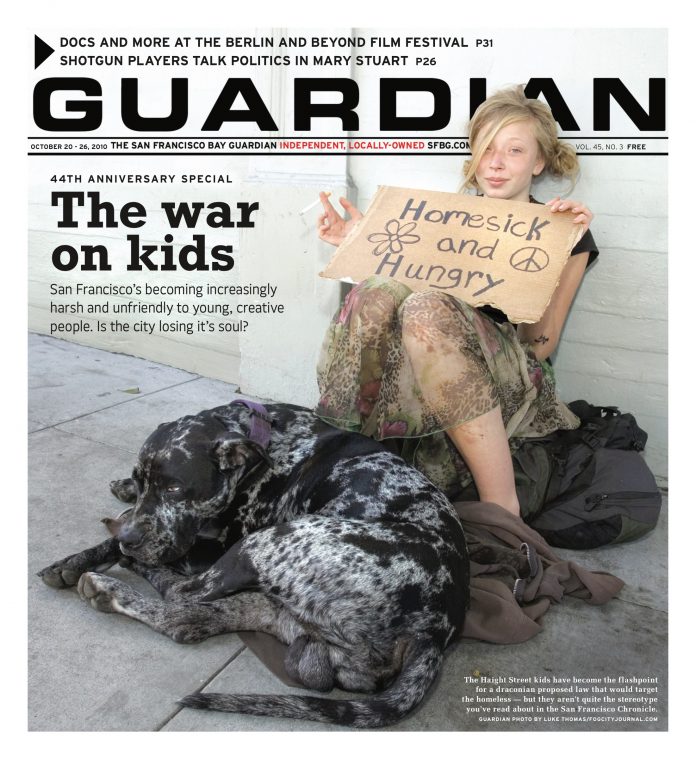arts@sfbg.com
MUSIC I’m bugging out. The evening has somehow melted into the early hours of the purple morning. Civilization II has sucked me into an imperialist warp zone on the buzzing computer screen. Pizza boxes litter the room. I’ve just started high school in Los Angeles and discovered the psychedelic powers of a magical herb that grew in Ziploc bags. My little spatio-temporal world has shifted.
On the radio, J.Rocc mixes Mos Def’s “Universal Magnetic” into Quasimoto’s “Come On Feet,” an otherworldly meditation on paranoia and the endlessly running human spirit. Come on feet/Cruise for me, wheezes a disembodied voice from Planet Helium. On the screen, my Egyptian chariots slaughter the Greeks. I don’t yet know that Madlib’s hypnotic sample for the Quas cut comes from the score of René Laloux’s 1973 animated film, Le Planete Sauvage — a story about tiny, heartfelt humanoids who wage a revolution against an oppressive, hyperrational alien species. The vocals trace back to 1971, when Melvin Van Peebles shattered sterile genre lines with his film Sweet Sweetback’s Baadasssss Song, in which a charismatic black male protagonist tries to escape from the forces of parasitic white authority. History reinvents itself. I feel dizzy. One of my chariots lost in battle; I click undo. J.Rocc blurts out: The World Famous Beat Junkiiiiieeees. Was everyone some sort of addict gone ballistic?
“The radio programs Friday Night Flavas and the Wake Up Show were influenced by KDAY,” Rhettmatic — one of the original members of the Junkies — tells me 10 years later, over the phone. “They were the ancestors of KDAY.” During the mid-1980s, Los Angeles youth (perhaps adults too), across the far reaches of the monstrous city, would climb their roofs and position radio antennas to catch the fuzzy frequency of 1580AM. It was the only dial on the West Coast championing hip-hop. The KDAY mixmasters, from Dr. Dre to Joe Cooley, would get down for extended traffic jam mixes, showing off their skills by scratching and blending poly-percussive electro jams with vintage soul and new school raps. A new generation of multilayered street style and consciousness was born.
By the late ’80s AM radio gave way to the stronger frequency modulation (FM), and the MC slowly pushed the DJ into the background. KDAY disappeared and N.W.A. introduced the world to a hyperbolic Compton. “When KDAY went off the air and the mixmasters disbanded, there was no all-star DJ crew,” says Rhettmatic. “J.Rocc wanted a crew of all-star cats, and we were all already friends, so that’s how it came about.” The year was 1992, and the World Famous Beat Junkies, not so famous yet, emerged from the backwaters of Orange County, the fairy tale hotbed of conservatism, known to most for Disneyland and surfing more so than the avant-garde.
For the next decade, the Junkies combined forces with Bay Area mix wizards, giving the group more members to push the craft of DJing over and beyond. They competed on the battle circuit and helped carve out the aesthetics of turntablism, the technical art of DJ battling. “We combined styles,” Rhettmatic says. “The East Coast’s X-Ecutioners had a funky style with beat juggles and body tricks. San Francisco, with the Invisibl Skratch Piklz, was doing crazy fast scratches. We took both of them and created our own hybrid style.” The Junkies also pivoted the DJ back to the center of the hip-hop group: Rhettmatic DJed and produced head-nodding beats for the Visionaries, while Babu anchored Dilated Peoples. Sales of Ziploc bags skyrocketed. And the Junkies helped shape, in turn, a unique underground style of California hip-hop, where street smarts did windmills around a surreal tableau of cosmic imagery.
Every Californian obsessed with hip-hop of the age remembers when the three volumes of Beat Junkie mixes dropped in the late ’90s. Minds were blown. Heads got knocked. Boomboxes short-circuited. And so on. Each volume mirrors a radio show, influenced by KDAY programming as much as New York Mister Magic broadcasts and Red Alert tapes. “The mixes were done on analog cassette four-tracks,” Rhettmatic says. “They have that pop and hiss feel.” The radio program format glued together the off-the-cuff style of the underground to a decidedly patchwork narrative structure. Dirty drums carried spontaneous flows while blunted bass pushed intoxicating rhyme schemes. When the lyrics faded away, the beat would kill it.
The Junkies took on the role of hosts as much as curators — placing new artists like Slum Village and Jurassic 5 within the momentum of the tradition. All the while, they stamped the mixes with individuating styles, and reconfigured the tradition through a cipher approach to blending and scratching records, samples, vocals cuts, and loops. “We come from a generation where you have to be original and stand out,” Rhettmatic says. What emerged was frenetic and unbounded, both a testament to the creativity of the collage and the groundwork for the instrumental hip-hop, and its mutated progeny, popularized today.
The Junkies have since focused on numerous individual projects — from Rhettmatic’s duo record with Michigan-based MC Buff1 to J.Rocc’s much-anticipated solo debut on Stones Throw — which make the opportunity to see them collaborate together on six turntables and four mixers this Saturday at Mighty a truly rare one. “A lot of people know us as turntablists, but we are all around DJs,” Rhemttmatic says. “For us, DJs had to do everything.” You can call DJ love a habit. But I’ll leave it to Lord Zen from the Visionaries to close with a verse from “Blessings”: You can’t get this dope without a prescription/Over-the-counter versions fell prey to addiction.
FREQUENCY: A BEAT JUNKIE TAKEOVER
Rhettmatic, J.Rocc, Babu, and Shortkut with Mr. E
Sat/23, 10 p.m., $10
Mighty
119 Utah, SF
(415) 762-0151

